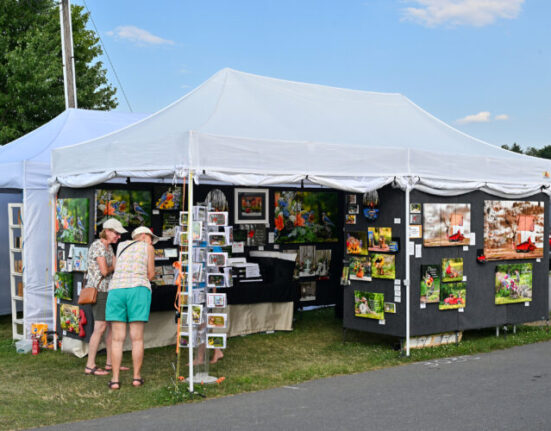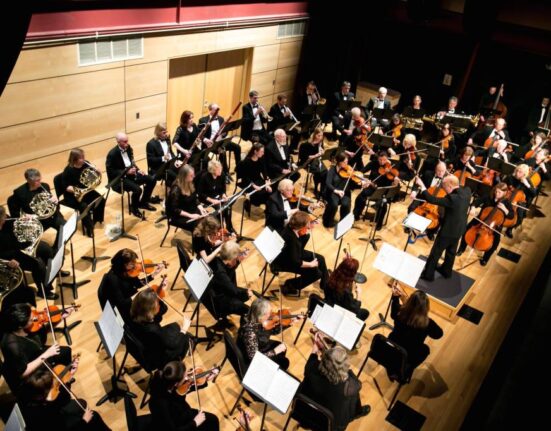
Courtesy of Amanda Duchen and Marjorie Wolfe
Kehler Liddell Gallery honored the end of its most recent exhibition with a public closing reception on Nov. 12.
KLG is an art collective located in the Westville neighborhood at 873 Whalley Ave. The gallery represents 22 of New Haven’s notable and emerging artists. The latest exhibitions that closed earlier this month were “HEDGE,” by photographer Marjorie Wolfe, and “CLAY,” by ceramic artist Amanda Duchen.
“This gallery has been great for women,” Wolfe told the News. “We’ve had all kinds of wonderful people represented here who no longer show their work here but have done amazing things — Emilia Dubicki, Susan Clinard. I mean, these are big names in New Haven art.”
Wolfe grew up in Beaver Hills, the neighborhood just beside Westville, where KLG is located.
Wolfe’s idea for HEDGE began two years ago when she was visiting Martha’s Vineyard. There, she photographed a hedge on the island. She later returned to it in the following months to find that, after the season change and a huge snowstorm, the hedge looked drastically different.
In this way, Wolfe’s work is reminiscent of Monet’s “Rouen Cathedral” series. The intentions of both artists are the same: to photograph a static object as the world around it changes.
For Wolfe, this exhibition is also nostalgic and personal.
“I first had an experience with hedges when I was about four years old. I lived on a street exactly one mile from [KLG] and to get to my best friend’s house I would [go through] a hedge with an opening in it just big enough for a little girl to crawl through,” Wolfe said. “So [with this exhibition] I was kind of coming back to something that was in my mind all along. It struck me this morning [that] this little girl, my best friend who I would crawl through the hedge to visit, it would be her birthday. She’d be 75 today.”
As a child, art was always a part of Wolfe’s life. At an early age, her parents encouraged her to take art lessons outside of school.
It was this love for art that led Wolfe to the Rhode Island School of Design, where she received her bachelor’s in painting and took her first photography class.
“Junior year I had one class in photography as an elective,” Wolfe told the News. “It was that slap upside the head moment, aha, too late.”
While it was have been too late for her to switch majors, that did not stop Wolfe from pursuing photography. She said that many of the art techniques that she learned from painting were directly transferable to this new medium.
Studying painting allowed Wolfe to learn composition, which could then be applied to her photography, to determine “what belongs in the frame,” as she put it.
Wolfe has gone to great lengths to capture the perfect composition. Once, when photographing a sports car in front of a gigantic hedge in California, she laid down on the road to get the shot.
She recounted another time when she ran — camera bag and all — to chase a composition for her photograph “Ocean Park Hedge.”
“[And so I’m] running up the hill thinking ‘get this picture before that cloud goes away’ because the cloud makes it. So that was a lucky photograph,” Wolfe recalled.
The photo, “Ocean Park Hedge,” demonstrates repetition of shape. In the foreground, there is a group of round hedges off to the left. In the background, the clouds in the sky mirror the shape of the hedges.
Repetition is pervasive in Wolfe’s photographs. In “Wainscoting” the sharp edges and repeating vertical lines of a staircase create a compelling composition. Similarly, in “The Road to San Galgano” the perspective provides the viewer with a diverging path lined with trees, which creates a linear structure and a repeating pattern of the trees on either side.
Wolfe taught photography to high school students for 37 years. She said that finding perspective was something she always instilled in her students.
“I would teach my kids if you find something that you think is going to make a good image, before you release the shutter, just step to the right or left or just kneel down a little bit and see how it changes through the viewfinder,” Wolfe said. “Stand on your toes. Just make sure you have the best composition.”
The second exhibition on display was the work of Amanda Duchen. Duchen is a trained architect from South Africa. In addition to architecture, she also creates works of art using clay.
A common technique that Duchen utilizes is raku. Raku is a Japanese firing technique for pottery where it is first fired at a lower temperature and then moved while hot. Transferring the pottery from the kiln while it is still hot causes a shock to the clay. As a result, the glaze crackles. The next step is putting the pottery in a container filled with combustible material which causes a reaction within the pottery that creates unique colors and patterns.
“What’s so lovely about raku [is that] it’s so unpredictable,” Duchen said.
Though Wolfe and Duchen are working with different materials and subject matter, there is some overlap with the nature motifs present in their works.
Duchen’s exhibition consists of several of her wheel-thrown ceramic bowls and other vessels, many of which use the raku technique or a variation of the technique, called naked raku. This variation creates a different effect due to the second porcelain slip that is added to serve as a barrier glaze. The slip eventually peels away to reveal a smoke-like design as the combustible material is able to permeate through.
Another technique Duchen uses in her work is inscription. Carving into the clay while it is still malleable allows Duchen to write quotes and phrases on the inside of the bowls.
In one instance, she inscribed the words of Rudyard Kipling, “I am by calling a dealer in words and words are, of course, the most powerful drug used by mankind.”
Beside the bowls were a set of seed-shaped vases. Within them were South African protea flowers.
When asked about the influence of South African culture on her work, Duchen said, “There’s definitely a strong connection with Africa. The gourds, or seed-like vessels, are very African.”
She also mentioned that the smoke-firing technique is a common practice among South African potters.
Another feature of Duchen’s exhibition, aside from the ceramic bowls, was a series of hand-molded figures. The figures were animalistic, resembling goats and canines.
The animal figures incorporated used objects and little trinkets that Duchen had collected, such as miniature light bulbs and sugar tongs.
The News spoke with another KLG artist Eddie Hall, who was helping manage the closing reception for Wolfe and Duchen’s exhibits, about his time at the gallery.
“It’s been a great experience,” Hall said, “It’s a lot of artists working together. We share the responsibilities. It’s a great combination of artists and brings a lot of diversity of art.”
KLG exhibited their annual Deck the Walls event starting Nov. 16 and will remain up until Dec. 24.






